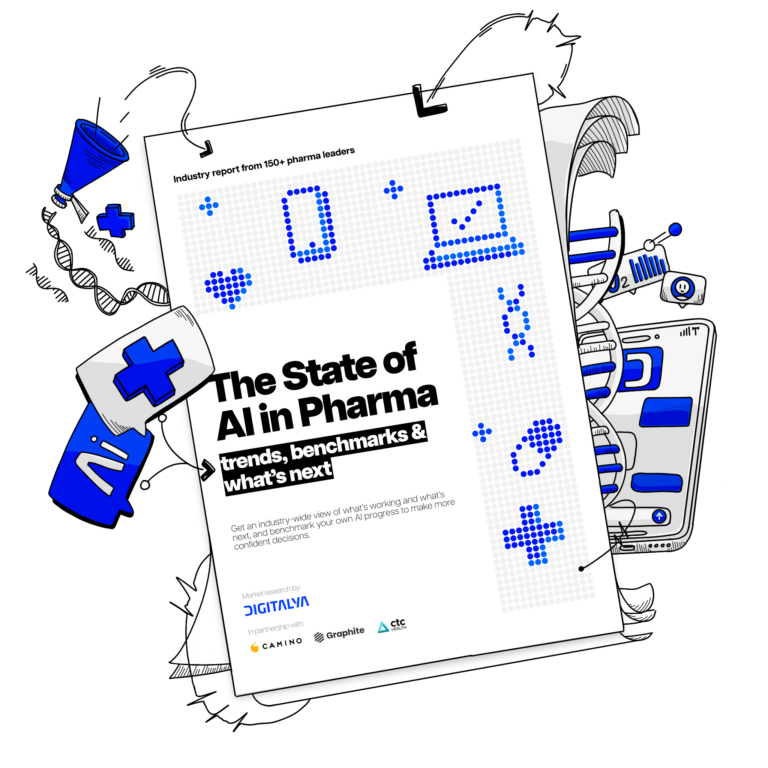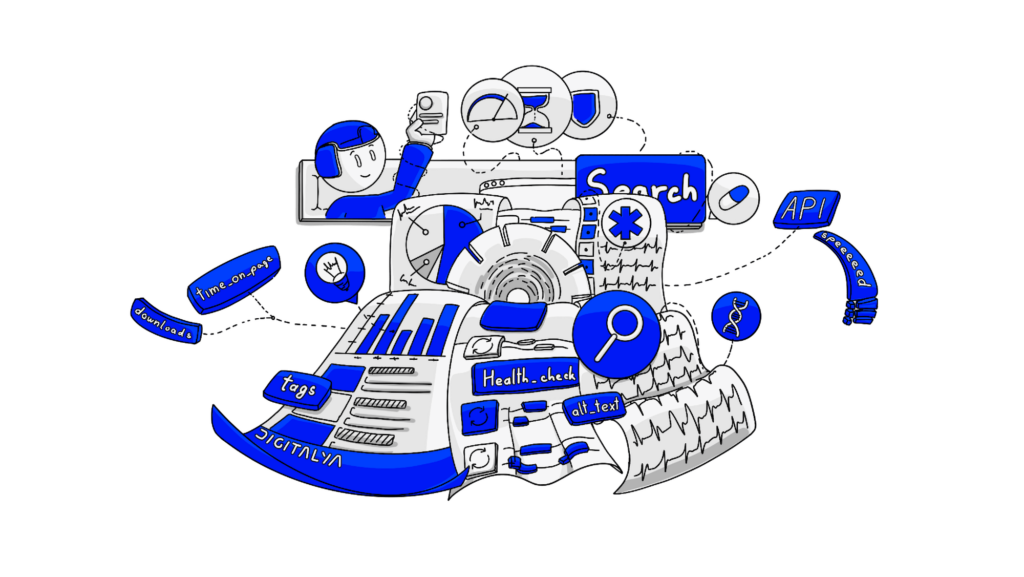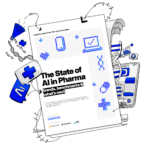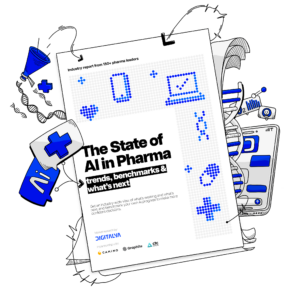1. The challenge of personalized medicine
Personalized medicine is the cornerstone of modern healthcare, aiming to tailor treatments to individual patients’ unique characteristics.
As defined within the EU’s research and innovation funding program ”Horizon 2020,” we are talking about “a medical model using the characterization of individuals’ phenotypes and genotypes (e.g., molecular profiling, medical imaging, lifestyle data) for tailoring the right therapeutic strategy for the right person at the right time, and/or to determine the predisposition to disease and/or to deliver timely and targeted prevention.”
Plus, the integration of genetic factors and molecular data, such as DNA variations and molecular interactions, is crucial in enabling personalized medicine by improving patient stratification and optimizing treatment responses.
Medical and life science have evolved immensely in this regard, but achieving this level of customization presents challenges for pharmaceutical companies.
Luckily, we live in the big data era, and big data in pharma represents the gate to many breakthroughs in personalized medicine.
1.1 The rising demand for personalized treatment options
As patients increasingly seek treatments tailored to their specific needs, the demand for personalized medicine is rising.
This shift underscores the necessity for pharma companies to adapt their approaches to drug development and patient care. We’ve talked about how strong patient engagement and efficient patient engagement tools improve health outcomes.
Patients are ready to embrace the next step in medical care, namely using personalized treatments based on big data pharmaceuticals, which can lead to improved patient outcomes.
A good example is the fast emergence in the U.S. of so-called concierge medicine — a customized approach to healthcare working on a membership basis, combining personalized care, exclusivity, accessibility, and convenience.
Exclusivity and membership services are nothing new; we are perfectly aware of the public’s appetite for them.
Still, medical care was not the first domain that came to mind. Yet, we witness an increase in demand for personalized treatment options.
In 2023, the market for concierge medicine was estimated at $6.7 billion. Its compound annual growth rate from 2024 to 2030 is expected to reach 10.37%.
Industry players need to take this trend very seriously, focusing on the use of big data in pharmaceutical processes and the way artificial intelligence can revolutionize pharmaceutical research. Patients are ready for personalized treatments, but are pharmaceutical companies ready, too?
1.2 Limitations of traditional one-size-fits-all approaches
We are still at the beginning of big data pharma and personalized precision medicine (PPM).
Traditional healthcare models often rely on one-size-fits-all treatment approaches, even in the current drug discovery process, overlooking the diverse needs and responses of individual patients.
This approach has long proven its limits in terms of suboptimal outcomes and inefficient resource allocation.
Research has shown that 4 to 10% of patients with a particular genetic profile who are treated with certain prescribed drugs manifest serious adverse side effects, many of which require medical treatment or are even fatal.
At the same time, data shows that of all hospital admissions, between 5 and 8% are caused by an adverse drug reaction.
Monitoring adverse events and analyzing adverse event reports are critical for pharmacovigilance and safety monitoring, as they help identify safety concerns and improve treatment protocols.
The percentage may not seem high, but in terms of costs at the health system level, it becomes expensive. A study by a group of researchers from Leiden University Medical Centre (LUMC) in the Netherlands has found that drug prescribing that relied on genetic information resulted in up to 30% fewer side effects.
1.3 How big data offers a path forward
Big data has emerged as a powerful tool for overcoming the limitations of traditional healthcare approaches. We’ve already seen positive changes in managing electronic health records or developing pharma digital companions.
By harnessing vast amounts of data, pharmaceutical companies can gain valuable insights into patient populations and develop more targeted treatments.
So, the next big step is using technology and analytics of big data, along with data science to extract actionable insights from large datasets to further develop precision medicine.
2. Big data revolutionizing pharma research and development
Integrating big data into pharmaceutical research and development processes is revolutionizing the industry. Large patient datasets are already available until access to genetic information for the pharma sector is regulated and made possible on a wide scale.
By analyzing them using artificial intelligence and machine learning, researchers can uncover hidden patterns and trends that inform the development of new drugs and treatment protocols.
Big data is also transforming drug research by enabling more efficient evaluation and screening of drug candidates, ultimately improving the success rate of these compounds throughout the drug discovery pipeline.
2.1 Unveiling hidden patterns in large datasets
Big data analytics enables researchers to sift through massive datasets to identify correlations, trends, and outliers that may not be apparent through traditional analysis methods. This capability allows for a deeper understanding of disease mechanisms and treatment efficacy.
A well-known example of how big data analytics in pharmaceutical research has uncovered hidden opportunities is the common aspirin.
Everybody knows that aspirin is used for analgesia treatment. When information from the patient’s electronic health records (EHRs) was analyzed and integrated with surveillance data from post-marketing and pharmacological analysis, there was a surprise.
Researchers discovered aspirin’s potential to treat colorectal cancer. This couldn’t have been possible without the access, management, and analysis of such a large amount of data. Or at least not so fast and not so clearly.
As a result, the draft recommendation on aspirin as a preventive treatment for colorectal cancer was released in September 2015 by the US Preventive Services Task Force.
2.2 From clinical trials to electronic health records — A rich data landscape
Today, pharmaceutical companies can access diverse data sources, including clinical trial data, electronic health records, and real-world evidence, as well as lab test results, imaging data such as X-rays, MRIs, and CT scans, and unstructured data from patient records and medical reports.
These rich datasets are genuine treasures, awaiting to be leveraged. Researchers can generate insights that inform every stage of the drug development process.
Large-scale biorepositories facilitate access to unprecedented opportunities: searches take significantly less time, they can expedite discoveries, predictive modeling can shed light on disease-gene associations and disease exposure, and generative AI can accelerate pharmaceutical manufacturing for disease treatment.
More EHRs are now linked with bio-specimens, making it possible to connect the dots between demographic characteristics, behavior and lifestyle factors, symptoms, medical history, medication, treatments, and even clinical trial backgrounds or results.
These connections and data analytical processes can prove revolutionary for the pharmaceutical RD and business process in the pharmaceutical sector.
2.3 Leveraging software to extract meaningful insights
All these data sources mean nothing without the proper tools to harness their value. Software plays a crucial role in unlocking the potential of big data in pharma.
Digital transformation in pharma means using the right tools and software to reveal the meaning of the data available.
Advanced analytics tools enable researchers to process and analyze large datasets efficiently, extracting actionable insights that drive decision-making.
In this context, big data tools and big data technologies, such as machine learning and predictive analytics, are essential for managing and analyzing the vast amounts of pharmaceutical data stored in data lakes. These technologies help ensure data quality, support regulatory compliance, and optimize drug discovery and clinical trials.
For example, a research paper mentions the Connectivity Map (CMap) developed in 2006 by the Broad Institute.
The CMap has been successfully used for drug repurposing predictions concerning various disease conditions The CMap “catalogs transcriptional responses of human cells to chemical and genetic perturbation, which can be treated as a surrogate phenotypic screen for a large number of compounds.”
A new version of the CMap is now publicly available. Thanks to the new technologies, the dataset it now covers is over 1,000-fold scale-up compared to the original. It uses a profiling method called L1000 (978 landmark genes), which “can computationally infer the expression levels of 81% of non-measured transcripts.”
The amount of data with which the new CMap has operated can be summed up to these numbers: 27,927 perturbagens (small molecule compounds, shRNAs, cDNAs, and biologics) from 476,251 signatures, producing 1.3 million L1000 profiles.
No doubt, it is an enormous resource. Thanks to the latest software developments, it can also use and interpret other public transcriptomic databases.
All this computational effort that not long ago was not humanly possible can now lead to identifying potential drug repositioning opportunities and novel drug-disease connections.
3. Software — the engine of big data analytics for personalized care
Sophisticated software platforms serve as the backbone of big data analytics in pharma. These platforms facilitate data integration, analysis, and visualization, empowering researchers to uncover valuable insights that improve patient care.
Cloud computing provides the scalable infrastructure required for large-scale data analytics, enabling advanced applications such as machine learning and deep learning.
3.1 Machine learning and AI — empowering personalized treatment plans
Artificial intelligence (AI) and machine learning algorithms transform how pharmaceutical companies analyze data and develop personalized treatment plans. These technologies can identify patterns in patient data and predict individual responses to treatments with unprecedented accuracy.
As shown in the previous chapter, AI and machine learning can fast-track data collection, management, and analysis of an enormous amount of information regarding the profile of an individual: genetic variations, physiologic characteristics, environmental and lifestyle factors, along with the health history, previous treatments and responses to medication.
Without this technology, data integration at this level would not be possible. Personalized treatment plans become possible thanks to the current capacity to work with big data in pharma.
3.2 Advanced analytics for predicting patient responses to treatments
Advanced analytics techniques like predictive modeling and data mining enable researchers to anticipate how patients respond to different treatments.
By leveraging these insights, and ensuring the use of relevant data to guarantee the accuracy of predictive analytics, pharmaceutical companies can optimize treatment protocols and improve patient outcomes.
3.3 Real-world evidence — capturing data beyond controlled trials
Real-world evidence (RWE) provides valuable insights into how treatments perform in everyday clinical practice. By supplementing traditional clinical trial data with RWE, pharmaceutical companies can gain a comprehensive understanding of treatment effectiveness and safety.
Research and development specialists in the pharma industry no longer rely solely on trial data. With the use of big data in healthcare, they can access information from electronic health records, patient apps, or pharmacy and insurance claims.
The data collected from these sources is crucial for generating real-world evidence, as it provides a better understanding of patient use and responses to certain approved drugs that are already on the market from patient subgroups that may not be well represented in a clinical trial.
4. Implementing personalized treatment plans in clinical practice
Bringing personalized treatment plans from the research stage to clinical practice requires a multifaceted approach that addresses data collection, clinical decision support, and physician-patient engagement.
By leveraging big data, healthcare providers can make more informed decisions in clinical practice, using real-time data analysis and predictive modeling to guide treatment choices and improve patient outcomes.
4.1 Patient data collection and analysis
Effective patient data collection and analysis are essential for developing personalized treatment plans. Data type and data quality are paramount. Pharmaceutical companies must ensure access to a comprehensive patient data set while respecting patient privacy and data security regulations.
Addressing missing data is a key challenge, as incomplete responses in large datasets can introduce uncertainty and bias in analyses. Leveraging existing data effectively is also crucial for improving the accuracy and reliability of models used in pharmacological and AI-based research.
4.2 Clinical decision support systems for treatment recommendations
Clinical decision support systems (CDSS) leverage patient data and clinical guidelines to assist healthcare providers in making evidence-based treatment decisions.
When traditional control groups are not feasible due to ethical or logistical constraints, virtual control groups can be used to supplement clinical decision-making by simulating control groups with historical patient data.
By integrating CDSS into clinical workflows, pharmaceutical companies can ensure that personalized treatment plans are effectively implemented.
4.3 Physician and patient engagement strategies
Successful implementation of personalized treatment plans requires collaboration and communication between healthcare providers and patients.
Pharmaceutical companies must develop strategies to engage physicians and patients in the decision-making process and ensure adherence to treatment plans with the help of patient engagement tools like patient apps or a patient education platform.
5. Case Studies — software success stories in pharma
Real-life examples demonstrate how software solutions have enabled pharmaceutical companies to improve patient care and healthcare efficiency through personalized medicine initiatives.
5.1 Examples of software solutions driving positive outcomes
Researchers from Leiden University Medical Centre (LUMC), Netherlands, have used software to develop a „DNA pass” – a card containing information about the link between the genetic profile of an individual and the possible response to medicine due to certain genetic characteristics.
In the study, 7,000 patients from 7 European countries used these DNA passes for personalized drug prescriptions. The result? They registered 30% fewer side effects than the expected norm.
Genetic sequencing with the help of software solutions is on the rise, opening so many opportunities for revolutionary treatments.
The International Cancer Genome Consortium (ICGC) gathered more than 1 PB of storage for aligned sequencing reads from over 20,000 donors. According to a study, every 18 months, the public raw sequencing data doubles in size.
Another important application of big data analysis in pharma industry is drug repurposing. Thanks to software solutions that align EHRs and other patient data, researchers can identify new indications for existing drugs.
Barbiturate, for instance, is used for treating migraines. Thanks to new data and analytics, including vast amounts of research literature, it was discovered that it may be used to cure insomnia.
6. The future of big data in pharma and personalized medicine
Looking ahead, the future of big data in pharma holds promise for further advancements in personalized medicine.
Continued innovation in software tools and technologies will enable pharmaceutical companies to unlock new insights, deliver customized treatments, and reduce drug development costs and time to market.
Additionally, leveraging data will be key to unlocking new insights and driving innovation in pharma.
Patients will have access to performant, personalized treatment much faster than before, thanks to big data management and analysis that can speed up regulatory approval and the drug development process.
6.1 Ethical considerations and data privacy in pharma
As pharmaceutical companies leverage big data to inform personalized treatment plans, ethical considerations, and data privacy concerns are even more sensitive than ever before.
We are talking about the very core of individuality—a person’s genomic profile. It is essential to prioritize patient privacy and ensure that data usage complies with regulatory requirements.
In addition, using genetic data also becomes a matter of property rights. Who has the right to patent DNA sequences? Should they? How does that affect further research and the medical development process? The matter is still an open subject.
6.2 Continued innovation — new software tools and technologies on the horizon
The rapid pace of technological innovation presents exciting opportunities for the future of big data in pharma.
Emerging software tools and technologies promise to further enhance the industry’s ability to deliver personalized medicine and improve patient outcomes. In addition, compliance big data solutions are emerging to help pharmaceutical companies meet regulatory requirements, ensure quality control, and streamline documentation and monitoring processes.
We talked about drug repurposing. A widely used method is network-based cluster approaches.
Deep learning algorithms are applied to dig deep into the hidden layers of vast data sources. These include deep belief networks (DBN), the convolutional neural network (CNN), deep auto-encoder networks (DAENs), and recurrent neural networks (RNN).
Thus, useful features are directly extracted from the raw data, resulting in new responses, and further classification is done more efficiently.
6.3 The promise of precision medicine — a future of customized treatments
Precision medicine holds the potential to revolutionize healthcare by offering customized treatments tailored to individual patient’s genetic makeup, lifestyle, and environment.
As pharmaceutical companies continue to harness the power of big data and software analytics, the promise of precision medicine draws nearer, with big data playing a crucial role in accelerating clinical development for customized treatments.
7. Conclusion
In conclusion, big data and software analytics have emerged as invaluable tools for pharmaceutical companies seeking to deliver personalized medicine.
The pharmaceutical industry benefits from big data in areas such as supply chain optimization, regulatory compliance, and overall efficiency, enabling improved cost reduction, timely delivery, and better decision-making.
Plus, by harnessing the power of data, software, and advanced analytics, pharmaceutical companies can empower healthcare providers to deliver customized treatments that improve patient outcomes and enhance healthcare efficiency.
7.1 Empowering pharma companies to deliver personalized medicine
As the demand for personalized medicine continues to grow, pharmaceutical companies must embrace big data and software analytics to meet the evolving needs of patients and healthcare providers.
7.2 A collaborative approach — software developers and pharma working together
A collaborative approach between software developers and pharmaceutical companies is essential to fully realizing the potential of big data in pharma. By working together, these stakeholders can drive innovation, advance personalized medicine initiatives, and ultimately improve patient care worldwide.







